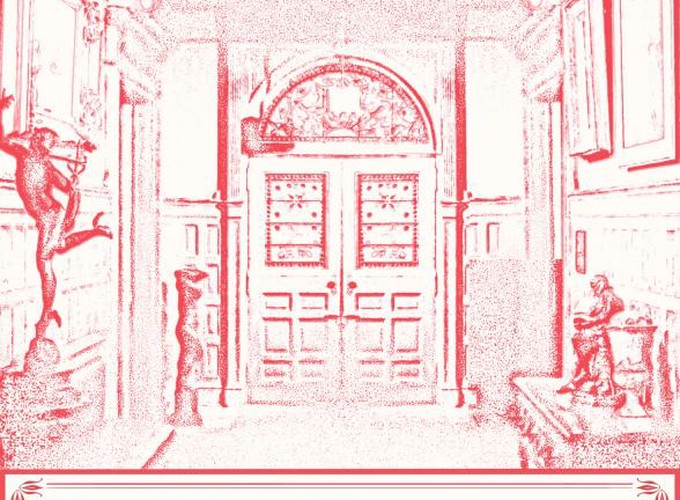This blogpost discusses a Zoom-based Escape Game Experience developed in collaboration with Newark Museum of Art.
We built a one-hour experience that allowed large groups of players (50+) to work in small teams to solve puzzles related to the Ballantine House and it’s history. The game has a single host (a member of the education team playing the character of maid or butler) that allows them to manage the entire experience.

The game premiered at Newark Museum’s ‘Game On’ public community day where we ran 3 games with ~25 players in each game. It attracted attendees from all over the world, not just Newark. Overall, I’m delighted with what we produced as a team in just a month and the feedback from players was very positive.
The game will now be used by the educational team and also for the general public on special days.
This game deserves a much better trailer – but I threw this together using PowerPoint in a matter of minutes.
Escape Game Intro
If you want a bit of a grounding in Escape Games then start here. Or if you want some suggestions of post-COVID Escape games click here.
I make a variety of Escape-Game like experiences so there’s a bunch of related tutorials on my website too app-based and web-based.
You can also read about another Escape Game project with a museum here or Immersive Theatre meets Escape Games.
Basically, I make real-world games. Games that take place in the real-world instead of in front of a screen. This is a combination of videogames, theatre, technology and actors. It used to be complicated to explain what I do but now that ‘Escape Game’ has entered common language it’s easier to say I make things like Escape Games. I’m interested in pushing this in different directions and games like [renga], A Moment of Madness and SCOOT3 try to do this.
So COVID19…
is not great news for someone who makes experiences to encourage people to leave their homes to go to a public space to connect with the venue and other people.
PIVOT!!!
Since March I’ve been transitioning a bunch of my projects back into the mainly digital space. Probably the exact opposite of what I usually do!
Obviously, this wasn’t a problem just for me:
The Escape Room Industry
Covid19 has caused the Escape Games of the UK (and further afield) to close down temporarily. Some have decided to share their experiences in alternative ways. These often fit into one of 3 categories:
- Live Avatar or Live Stream – you play a real physical Escape Room but remotely – probably via Zoom. There is a real person in the room acting on your behalf.
- Print at Home – you download a pdf that you print (and possibly assemble) which contains puzzles and story. It’s also possible to have these mailed to you.
- Web-based – you access the content via a website (might also be an app). Similar style puzzles to the Print at Home, but with the added advantage of interactive password / hints and video / audio.
That is a far from exhaustive list – there are lots of people doing really interesting versions of those above. And I think it’s worth saying that there were people creating these types of experiences way before Covid19 too. It does seem that social distancing has encouraged demand for these experiences so I’m sure they will stay around after lockdown is lifted.
So, if you’re thinking of building something like this for your museum then I’m sure you’ll have an audience both during and after COVID.
What did we set out to achieve?
So, working with Newark Museum of Art we started by figuring out the constraints for the project. It’s a fairly standard approach (aka Constraint-based Design) at the beginning of any project. We had an informal discussion about what they are thinking, what they’ve done before and things they’ve seen. Then from that begin to draw up a set of constraints for the project as a whole.
- How many players does it need to work for?
- How many staff can help to run it?
- Budget? On-going costs?
- Deadlines
- Who is part of the development or creative teams?
- Are there limits as to what bits of history we can / can’t use?

So, what were these constraints?
A Hosted Experience
The games will run at specific time slots and will take under an hour (all-in). It will take place over Zoom and have a live host who will run the show. In the early tests we had a stage-manager role (me) who handled everything that wasn’t related to the acting. E.g. zoom set-up, triggering videos, sending messages, starting break-out rooms, managing the end poll. As the host gets more experienced they can take over both roles – but it doesn’t hurt to have an extra pair of hands.
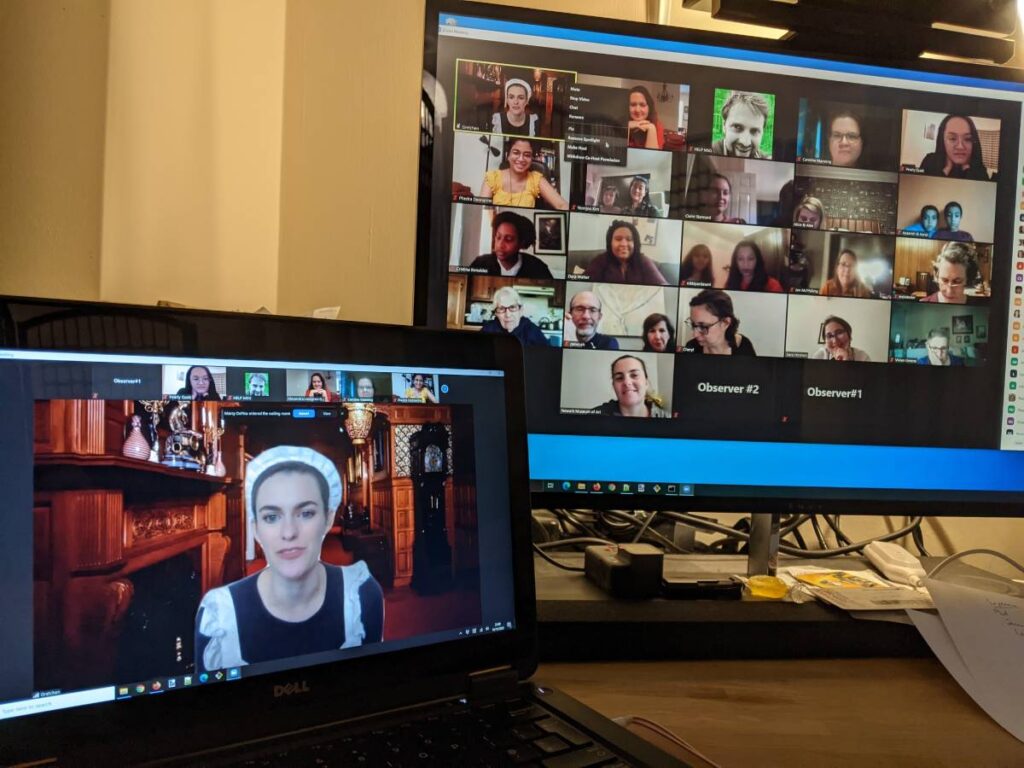
Target Audience
To be used as a long-term offering by the education team for school groups 11+. It’s also suitable for one off special events for the general public (either free or charged).
Player Numbers
It needs to work with school groups so will take substantially higher numbers than a real-world escape room of 4-6 players. So 25-50 players in the larger group who are split into teams of 3-5. The players start as a large group, get put into break-out rooms for the game ‘proper’ and then come back for an end game where they get to share some puzzle information and vote on an overall outcome. I won’t spoil this entirely for you 😉
Setting & History
We were fortunate to already have a setting to work with in the form of their historic building John Ballantine House. The John Ballantine House is set up as an historic house museum – usually allowing visitors to wander around and explore the rooms. It would have been fantastic if we could have got into the building to take the perfect photos we needed – but since this wasn’t possible we worked with what we could find.
Educational Content
This is always a tough one. Museum’s often have an educational focus but the primary goal of games is for entertainment. We have to be careful not to lose track of the entertainment purpose. Who wants to play a game that isn’t fun?
My focus is always ensuring that players have a very positive experience that makes them want to learn more. Many players expressed an interest in visiting the building in-person once it was open again.
We use real history in the game. It’s set in the 1890’s so everything in the game is appropriate to that year. All the characters and their relationships are real too.
It’s designed so that once the game is complete it’s the ideal starting point for further historical discussion. Also, in each room the puzzles are themed around specific topics, e.g. Immigration, Chemistry, Communications – so it would be easy to pick any of these areas as a starting point for further educational activities.
Iterative Development Approach
Games can be complex to develop – especially when it’s for a client – you need to take them on the development journey with you. It’s not something that you can just deliver at the end and hope that everyone is okay with. And it’s also adapted based on player experience. For this reason, it’s essential to adopt an iterative approach. These were our milestones over the course of just over a month.
- Build one level of the game (a room in our case)
- Iterate on this one level so everyone has a good idea of what the entire game might look like
- Build two levels of the game
- Build all levels of the game
- Feature complete (everything is there – but not polished)
- Playtests with staff
- Playtests with friends
- Playtest with public
You can start to see how intense the development cycle was. It’s important to show the game as often as possible to get feedback early. It’s okay to throw away assets that you’ve created – but it’s not ideal if you’ve spent a long time developing them. This means that playertesters need to use a certain amount of imagination as to what the final game looks / plays like. It’s always hard as the developer to make excuses for this too 😉
If possible, it’s incredibly useful to get player feedback at each stage. After each game we would have an informal chat with the players. However, just Watching your players play and listen to their discussions while they problem solve is the most valuable part though – so just hiding in the Zoom break-out rooms with my camera and microphone off was incredibly valuable. I often encourage playertesters to talk out loud as much as possible so that you can hear their thought processes – while a game like this they are naturally sharing this already.
Game Story
It helps to know a little of the story we created for our game. So John Ballantine (of Ballantine Brewing Company) and his wife are hosting a formal evening dinner reception and the players have been invited. While waiting to enter the house the player meets Kruger who makes a proposition to steal the secret Ballantine Beer recipe in exchange for a generous reward. The plan is that Kruger will keep the Ballantine’s distracted during dinner while the player sneaks around the house to find it.
Kruger has someone on the inside (a maid) who will be able to assist the player. Obviously, Krueger doesn’t give the player a chance to turn down his offer – so the game begins.

The player enters the Ballantine House where they are met by the maid. Once the maid realises who you are, she breaks from her standard welcome and she explains the situation and ushers you into the Billiard Room so that you can begin searching for the recipe. The players have ~40 minutes to solve puzzles and explore the house before dinner is over.
Game Structure & Player Agency
While we want the game to be suitable for up to 50 players in one session we don’t want that to be a single team of 50 players.
In larger teams players generally have less involvement & less agency. It’s easier for players to take a back seat. Sometimes this is the desired behaviour – but not in the case of this game.
Think of a football match. In a full size 11 a-side game we have 22 players and a single ball. Whereas in a 5 a-side game it’s just 10 players and a single ball. With a smaller number of players, each individual has more time with the ball and can have more involvement in a game.
In multiplayer games I often talk about ‘points-of-interaction’. How many ways can players interact with a game at the same time.
In a game of football we could introduce more balls to increase the number of points of interaction. Obviously, this is a very simplified case (as there’s plenty to do in football when you don’t have a ball) but hopefully you get the idea. You want more interaction elements as the player numbers increase.
What does this mean in our Escape Game. Well the easiest way is to have more elements when solving a puzzle so that it requires more people to handle items at the same time. This generally isn’t a hard limit – as we want the game to be scalable for small teams – i.e. 3-6 players. But it should still be possible to complete if players drop out for whatever reason.
In Escape from Ballantine House we solve this by having the puzzle elements that can be accessed by QR codes.
One player takes the ‘navigator’ role and moves the team around on instruction from the others. All players can scan the QR codes to view the puzzle elements closely via external micro-website.
The idea is to get players doing different things at the same time and therefore it creates a need to collaborate and discuss.
Immigration Puzzle Example
[NOTE: HUGE SPOILER – this includes puzzle elements from the game]
In this section we’ll look at a puzzle from the game. This puzzle appears in the Reception room just around the half-way point. I’ll present all the pieces and then let you have a play with them.
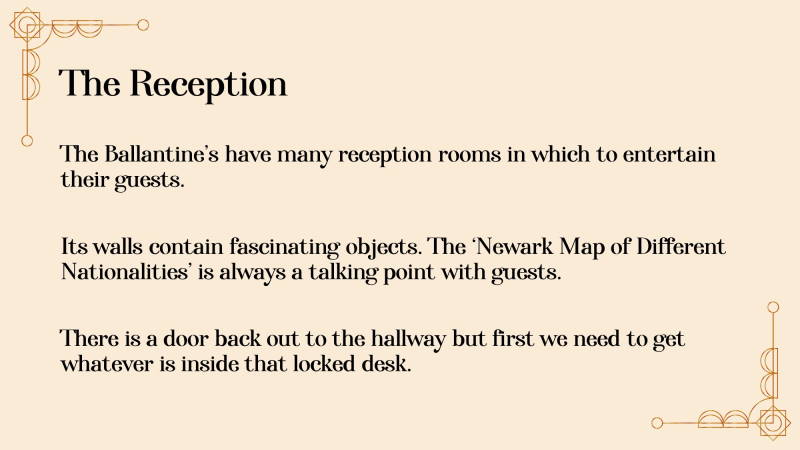
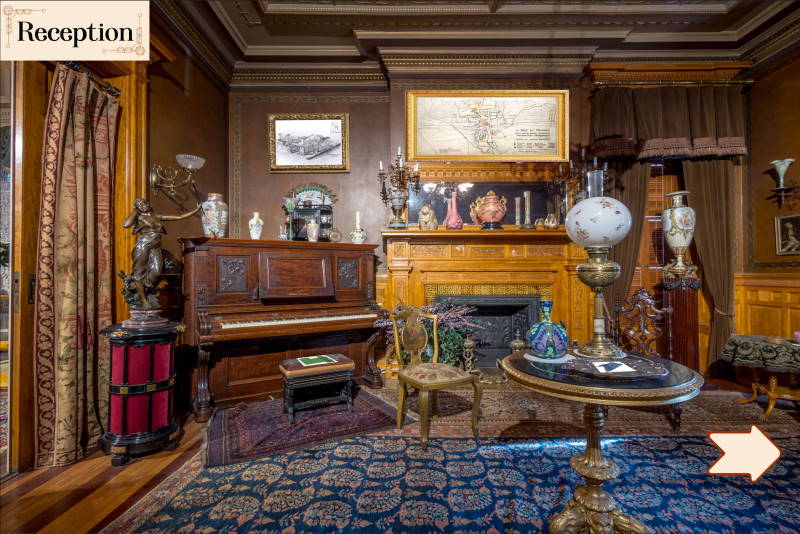
So there are two sections of this room to explore. The goal is to get into the desk drawer where you will find keys to get out of this room and into the Ballantine’s private library.
The main puzzle in this room centres around this amazing immigration map from 1910 (I’ve bent the timeline of the game slightly in order to incorporate this because I loved it so much). The map is a subsection of a larger map – which was reduced to both simplify and to make it work better on a phone.
It’s playing time! These elements are designed to be viewed on a mobile device – and the majority of camera apps (built in to android or iOs) are able to scan QR codes automatically.
You can view the map yourself by scanning the QR code here:
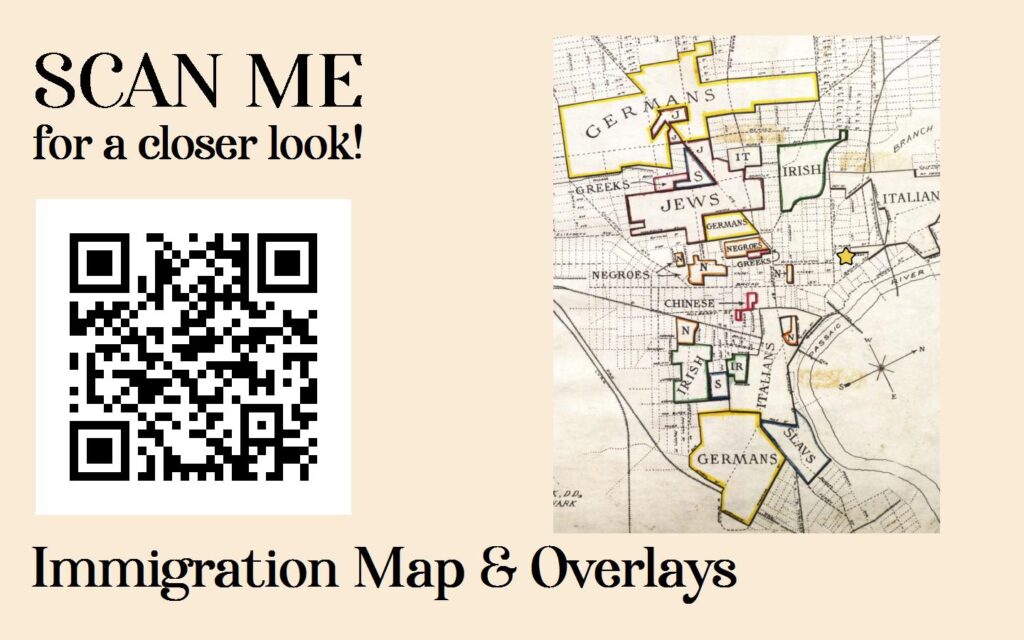
Around the room you find these map pieces which you can combine with the map. I’ll help you out finding those 🙂
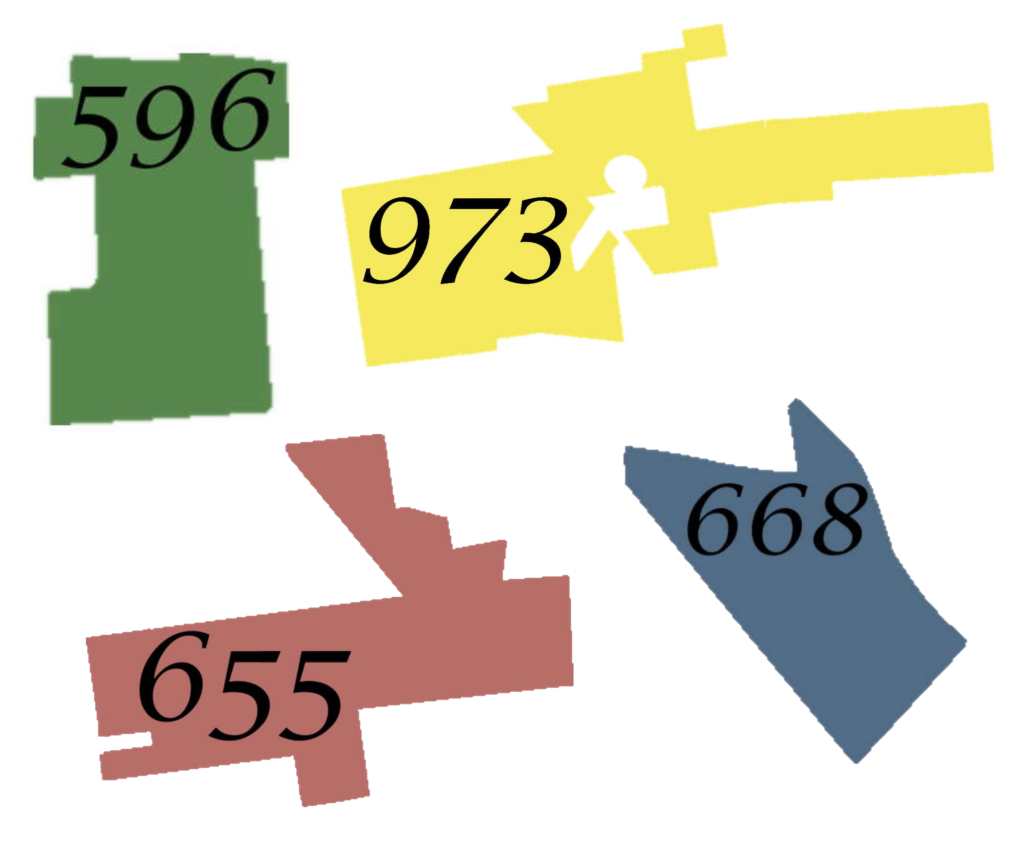
There’s also two more clues:
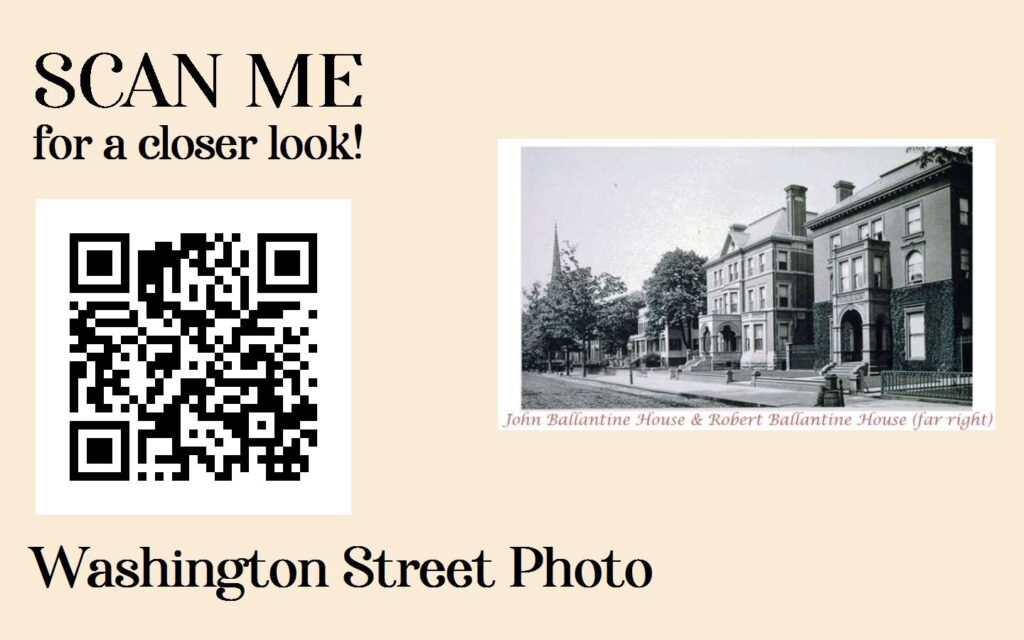
And here:
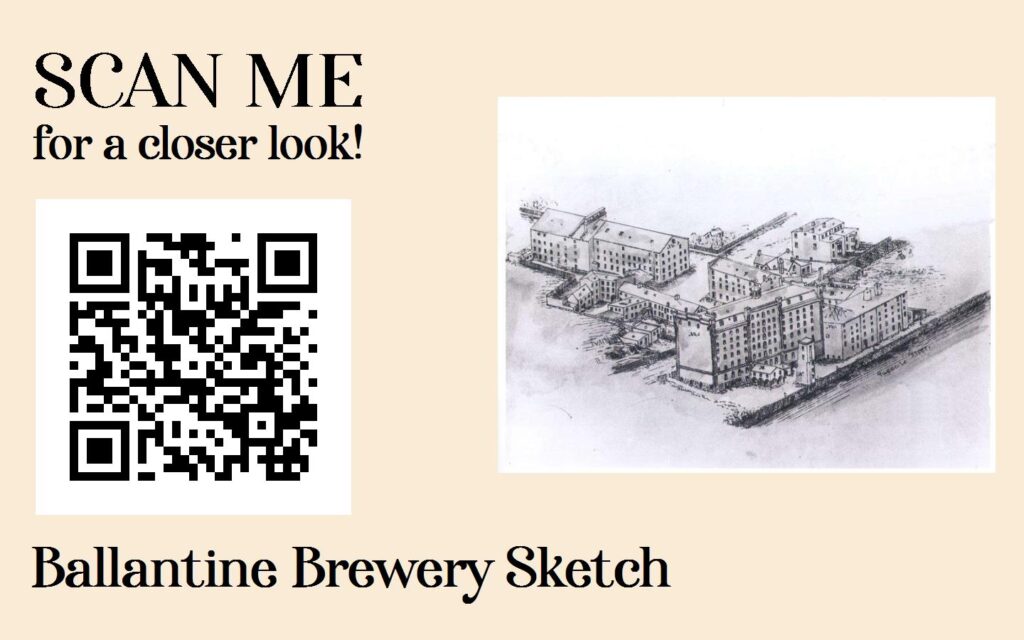
This puzzle is much easier with all the puzzle elements laid out in front of you. In the context of the game these pieces are split over several phones and players will have missed or forgotten about essential pieces. Usually, players will be describing parts to the rest of the team. Or someone taking a back seat will suddenly member an essential part.
It’s been designed so that you can solve it without finding all of the elements – and many teams will overlook one piece of the puzzle causing them additional work at the end.
To unlock the drawer in the game you need to click on the elements. For our web version you don’t get the benefit of that I’m afraid. You can check your answer here:
Don’t scroll across until you’ve tried yourself!
The answer to the puzzle is: VASE
Game Timeline (what happens during the hour)
As well as the planning the puzzles themselves – as this is also a live event we need to figure out a schedule of what is happening minute to minute.

- Pre-game registration using EventBrite – players receive their invitation
- Zoom Arrival
- Game Intro
- Pre-recorded video of Kruger
- Maid introduction & reveal that they are working with Kruger
- Break-out rooms (main game) 30-40 minutes
- Maid floats between rooms to monitor & assist
- We have target times in mind for the players to solve each room. So we’ll provide hints if needed to teams behind our schedule.
- End game answer & vote
- End pre-recorded video of Kruger
Game beginning
Getting the beginning of an immersive experience right is paramount and it sets the scene for the entire game. I was pitching for the players to be in the game-world right from the beginning. So, as soon as they join Zoom players are treated as if they are characters in the 1890’s and only get to interact with other 1890’s game characters.
I had originally envisaged it as an automatic start with a count-down to the beginning and then an automatic launch into the game. This means that provided you joined zoom within the 5 minutes period – you’d be met with an introductory video with some information, atmospheric music and a practice task to do.
The museum were more keen on an informal start and end to the proceedings. I completely agree with their decision on this. I think it was important for the museum to get an opportunity to speak to their players to find out where they were from and to give them some reassurance about the experience they had signed up to.
Easter Eggs
I always like to put some easter eggs in my games – mainly to amuse myself while I’m creating them. In this case I used the museum’s phone number, the birthdates of historical figures as answers to the puzzles. The final puzzle has the answer right in front of you – but no one will notice it 😉
Technology
In order to have multiple points-of-interaction it was important that Ballantine House and the puzzle objects could be examined at the same time. Since players are already using their laptops for the Zoom call – the option available to them is to use their mobile phone (or tablet). Ultimately, if players don’t have access to a 2nd device its possible to use the laptop for both – or rely on other players to show items to their camera.
Individual Puzzles
The individual puzzle elements are all micro websites. These were custom built for the different content:
- A book that you can turn the pages of
- Images that you can zoom into
- Items that you can flip over (e.g. postcard)
- Objects that can be rearranged (e.g. torn pages)
- 3D objects that can be rotated
- Overlaid objects (the immigration puzzle above)
I had a bunch more ideas for micro puzzle sites and ways that they could be reused to create more puzzles – just in case I get to build a similar experience in the future.
Ballantine House
In order to move around Ballantine House we needed to build what is essentially a point-and-click adventure game. It needed to work in a way that the players themselves could run and operate it without our assistance.
Rey, from Newark Museum, who worked closely with me on the technical development, had built an earlier prototype game. In this version the host took care of running the game locally and screen-shared it via Zoom taking instructions from the players. Rey built this using a piece of software called TyranoBuilder – originally designed for visual novels. It’s actually quite similar to what you can build in PowerPoint.
The good news is that the interactive elements in Visual Novels are quite similar to Point-and-click adventure games. The other piece of good news is that we could get TyranoBuilder to generate web versions of the games. This meant that we could put the game in the hands of the player rather than the host. Although, this meant reducing the complexity of the game so that it was essentially foolproof and timebounded.
Linking them together
The final challenge was linking these puzzle elements into the games. There’s a variety of ways to do this – but we opted for the simplicity of QR codes. They’ve had a new resurgence since native camera applications added support for scanning them.
I built a simple tool to generate the QR codes automatically and build an associated image so that it could be included in TyranoBuilder.
Building your own (low-tech)
If you’re building your own you can certainly use some of the principles described above even without the advanced technical approaches that we used. There’s numerous ways of doing this – but let me give you one example.
Something as simple as creating content, putting it in a google drive folder and sharing the link within Zoom will get you some of the way there. Make sure the folder is public and read only.
You could even set up a number of folders – each containing all the content for one particular puzzle. You just need a way to link from puzzle to puzzle. This could be as simple as using a bit.ly link with a custom shortname that redirects to the next folder. The players would need to add their answer to the end of the web address.
If there’s interest in this I’m happy to create a longer tutorial.
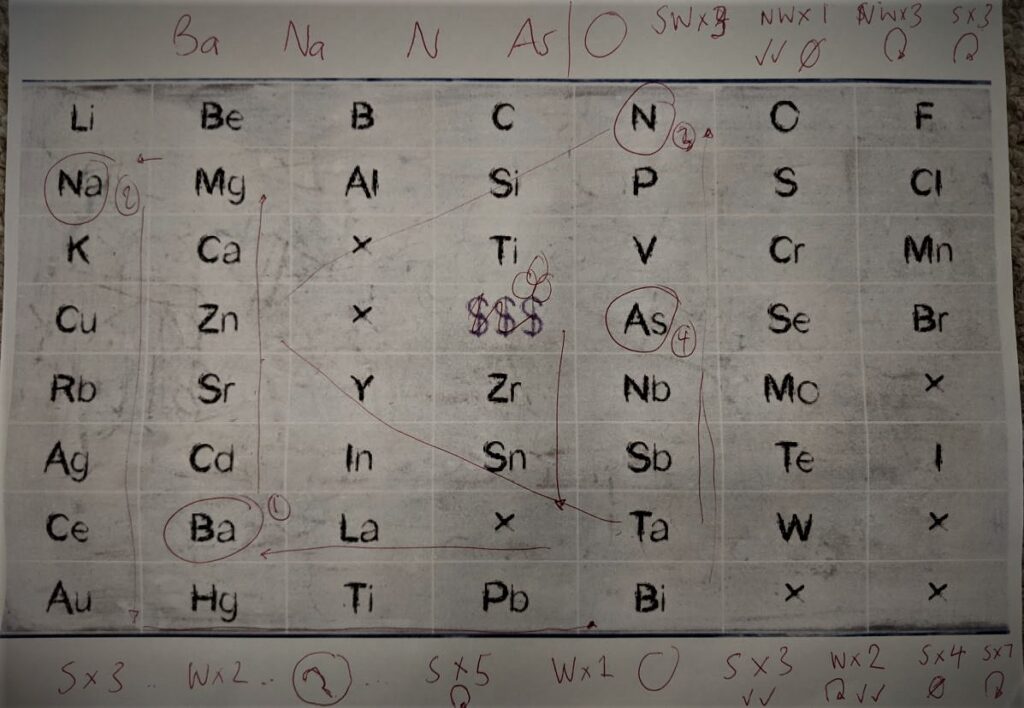
In Summary
I’m really pleased with what we achieved. I think it’s certainly pushing the boundaries for what museums are offering in the terms of interactive, virtual experiences.
I hope that more museums see ‘Escape from Ballantine House’ and it inspires them to build their own. For a while now I’ve been pitching the idea of Immersive / Escape Game style experiences in historical / stately homes – Escape Rooms can only hope to emulate these environments. (This is for another blog post.) Until then virtual Escape Games set in these fantastic environments is a way that our visitors can enjoy these spectacular venues during COVID or even post-COVID times. Maybe they will become as commonplace (or as an added extra) to the 360 virtual tour.
Thank you!
This project was certainly a team-effort and we met multiple times a week to share and review progress. So a few shout-outs to the rest of the team!
Huge thanks to the creative team at Newark Museum of Art: Silvia, Maegan, Shirley and Rey. Silvia for taking the Director role and having the vision to create something so adventurous, Maegan for Producing the entire project, Shirley for the original story idea and educational input and massive thanks to Rey for sharing the technical implementation with me. Special thanks also to the two original Maids: Kirsten & Alyse and to Richard Crowest who did the perfect job of bringing Kruger to life.
